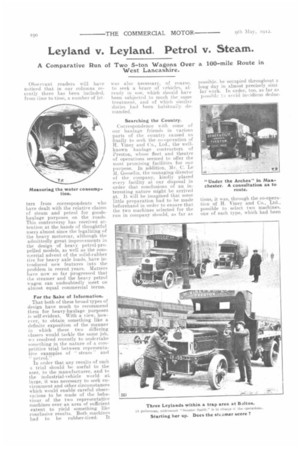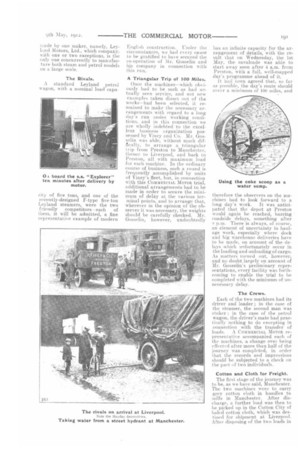Leyland v. Leyland. Petrol v. Steam.
Page 4

Page 5

Page 6

If you've noticed an error in this article please click here to report it so we can fix it.
A Comparative Run of Two 5-ton Wagons Over a 100-mile Route in West Lancashire.
Observant readers will have noticed that in our columns recently there has been included, from time to time, a number of lel
ters from correspondents who have dealt with the relative claims of steam and petrol for goodshaulage purposes on the roads. This controversy has received attention at the hands of thoughtful users almost since the legalizing of the heavy motorcar, although the admittedly great improvements in the design of heavy petrol-propelled models, as well as the commercial advent of the solid-rubber Lire for heavy axle loads, have introduced new features into the problem in recent years. Matters have now so far progressed that the steamer and the heavy petrol wagon can undoubtedly meet on almost equal commercial terms.
For the Sake of Information.
That both of these broad-types of design have much to recommend them for heavy-haulage purposes is self-evident. With a view, however, to obtain something like a definite exposition of the manner in which these two differing classes would tackle the same job, ws resolved recently to undertake something in the nature of a competitive trial between representative examples of " steam " and " petrol." In order that any results of such a trial should be useful to the user, to the manufacturer, and to the in world at large, it was necessary to seek environment and other circumstances which would enable careful observations to be made of the behaviour of the two representative machines over an area of sufficient extent to yield something like conclusive results. Both machines had to be rubber-tired. It was also necessary, of course, to seek a brace of vehicles, already in use, which should have been subjected to much the same treatment, and of which similar duties had been habitually demanded.
Searching the Country. Correspondence with some of our haulage friends in various parts of the country caused us finally to seek the co-operation of H. Viney and Co., Ltd., the wellknown haulage contractors of Preston, whose fleet and theatre of operations seemed to offer the most promising facilities for our purpose. In addition, Mr. C. Le Gosselin, the managing director of the company, kindly placed every facility at our disposal in order that conclusions of an interesting nature might be arrived at. It will be imagined that some little preparation had to be made beforehand in order to ensure that the two machines selected for the run in company should, as far as possible. be occupied throughout a long day in almost precisely similar work. In order, too, as far as
possiblr aveid invidious deduc tions, it was, through the co-operation of H. Viney and Co., Ltd., possible to select two machines, one of each type, which had been made by one maker, namely, Ley1,q11[' Motors, Ltd., which company, with one or two exceptions, is the only one concurrently to manufacture both steam and petrol models on a large scale.
The Rivals.
A standard Leyland petrol wagon, with a nominal load capa city of five tons, and one of the recently-designed F-type five-ton Leyland steamers, were the two friendly competitors—each of them, it will be admitted, a fine representative example of modern English construction. Under the circumstances, we had every cause to be gratified to have secured the co-operation of Mr. Gosselin and his company in connection with this run.
A Triangular Trip or 100 Miles.
Once the machines—which obviously had to be such as had actually seen service, and not new examples taken direct out of the works—had been selected, it remained to make the necessary arrangements with regard to a long day's run under working conchtions, and in this connection we are wholly indebted to the excellent business organization possessed by Viney and Co. Mr. Gosselin was able, without much diffealty, to arrange a triangular trip from Preston to Manchester, thence to Liverpool, and back to Preston, all with maximum load for each machine. In the ordinary course of business, such a round is frequently accomplished by units of Viney's fleet, but, in connection with this Commr.nciAL "MoToR trial, additional arrangements had to be made in order to secure the minimum of delay at the various terminal points, and to arrange that, wherever in the opinion of the observer it was necessary, the weights should be carefully checked. 'Mr. Gosselin, however, undoubtedly has an infinite capacity for the arrangement of details, with the result that on Wednesday, the 1st May, the cavalcade was able to start away soon after 4 a.m. from Preston, with a full, well-mapped day's programme ahead of it.
It had been agreed that, so far as possible, the day's route should cover a minimum of 100 miles, and therefore the observers on the machines had to look forward to a
long day's work. It was anticipated that the depot at Preston would again be reached, barring roadside delays, something after s p.m. There is always, of course, an element of uncertainty in haulage work, especially where dock and big warehouse deliveries have to be made, on account of the delays which unfortunately occur in the loading and unloading of cargo. As matters turned out, however, and no doubt largely on account of Mr. Gosselin's preliminary representations, every facility was forthcoming to enable the trial to be completed with the minimum of unnecessary delay.
The Crews.
Each of the two machines had its driver and loader ; in the case of the steamer, the second man was stoker : in the case of the petrol wagon, the driver's mate had practically nothing to do excepting in connection with the transfer of loads. A COMMERCIAL MOTOR representative accompanied each of the machines, a change over being effected after more than half of the journey was completed, in order that the records and impressions should be subjected to a cheek on the part of two individuals.
Cotton said Cloth for Freight.
The first stage of the journey was to be, as we have said, Manchester. The two machines were to carry grey cotton cloth in bundles to mills in Manchester. After discharge, a further load was then to be picked up in the Cotton City of baled cotton cloth, which was destined for shipment at Liverpool. After disposing of the two loads in the docks in that city, raw cotton was to be picked up from the huge cotton warehouses and carried back to the Mills at Preston. As a matter of fact, we may here say that this original programme was carried out without the slightest hitch, and with the minimum of trouble. The impressions which were conveyed to the observers were entirely in favour of road haulage in comparison with the conditions of railway transport for the same class of goods, for reasons which will be recorded later.
The Log of the Leyland Steamer.
It will be better, perhaps, for our readers if, in dealing with thf,
actual trips of the two machines we describe the two itineraries separately. For that purpose we will first of all give some idea. of the log of the Leyland steamer.
The steam wagon in question, which, in spite of accidentally running off the road two days previously, was none the worse for its adventure, was a coke-fired ma
chine. The only evidence of its mishap was the fact that it carried a bunker which did not belong to it. In fact, the steamer was No. 10 of Viney's fleet, whereas the bunker showed No. 5, a fact which caused some little qualms to the driver. This actual machine has been in bard service for over nine months,
and has given its owners entire satisfaction all the time.
The Surmounting of Black Rod.
Starting away something like three-quarters of an hour in advance of the petrol wagon, the steamer left the Preston depot at 4.40 a.m. on May Day, with a load of 4 tons 19 cwt. of cotton cloth in 122 rolls. This, as were all the other loads during the trip, it will be admitted, was a well-distributed load, and one which was not liable to shift. Getting away well over a road surface which was composed of stretches of granite setts, a bee line was made for Black Rod.
























